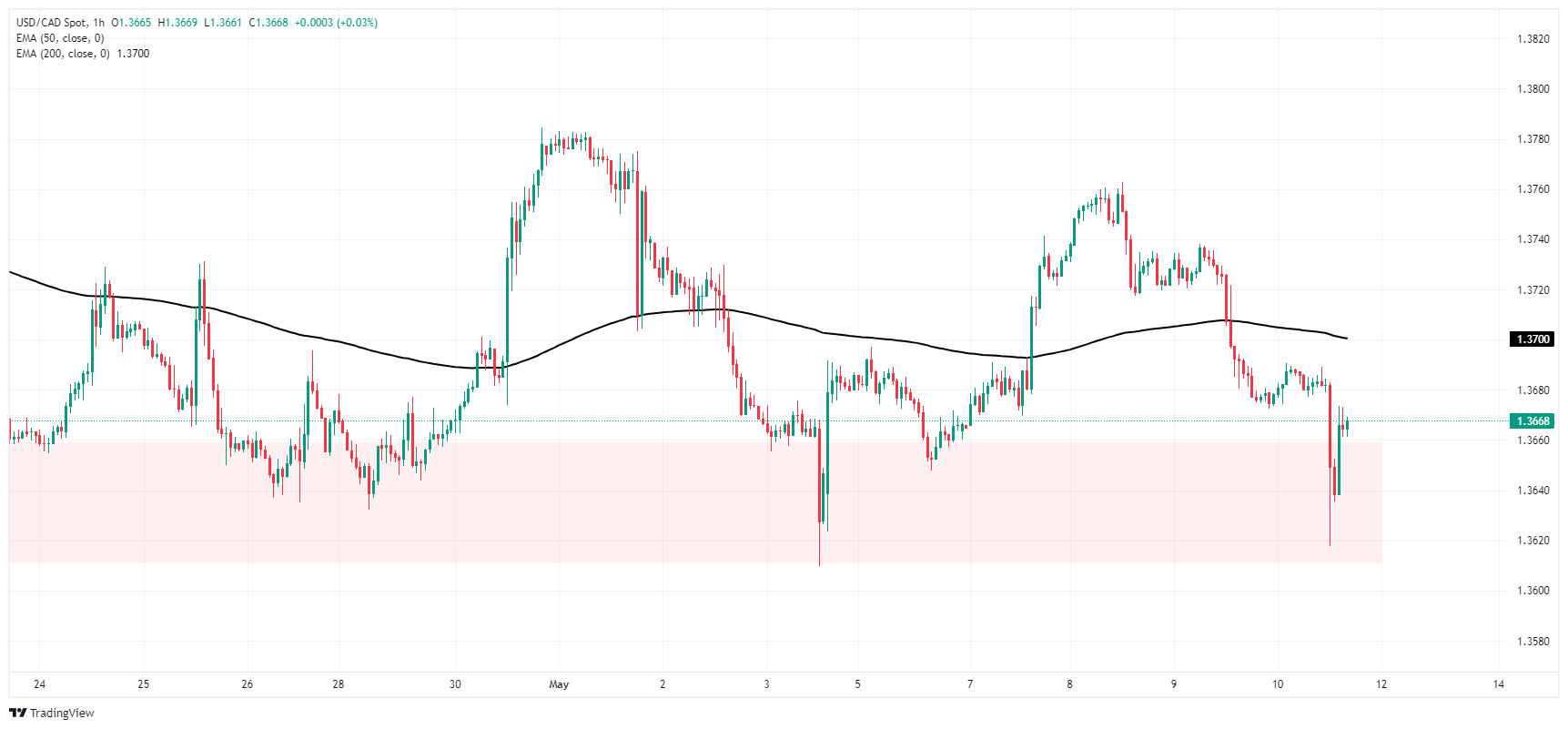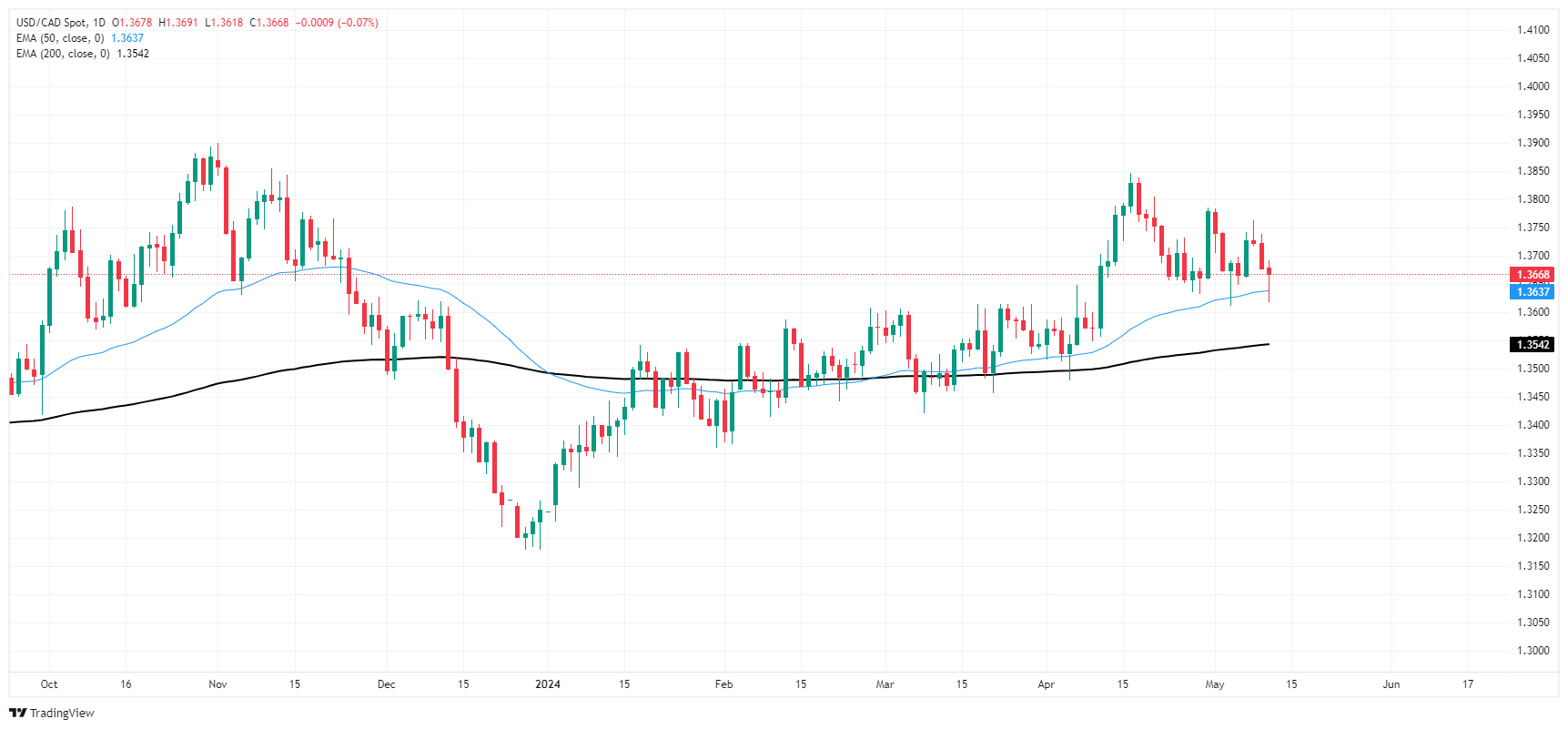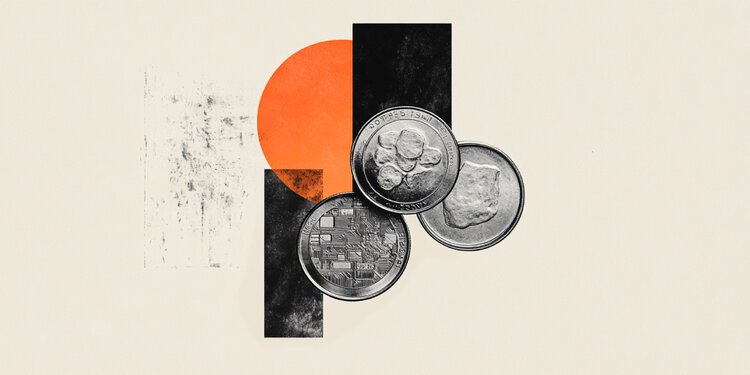- Canadian Dollar climbed on Friday, but Greenback remains popular bid.
- Canada added far more jobs than expected in April.
- US consumer sentiment tumbled, Fedspeak crimping rate cut hopes.
The Canadian Dollar (CAD) surged on Friday after the Canadian economy added five times as many jobs as analysts expected. However, risk-off market sentiment is limiting the CAD’s gains as the Greenback remains a popular destination for investors leery of hawkish Fedspeak and sour US consumer sentiment data.
Canada saw its highest net job gains in April since February of 2023, adding nearly 100K jobs to the Canadian economy, while the unemployment rate remained pinned at 6.1%. On the US side, both consumers and Federal Reserve (Fed) policymakers both see inflation sticking around higher and longer than rate-cut-hungry market participants have been hoping for. Risk appetite on Friday is on the wobbly side, limiting gains for the CAD.
Daily digest market movers: Canadian Dollar supported by jobs growth, but markets keep one foot in safe havens
- Canada gained 90.4K net jobs in April, beating the 18K forecast fivefold and erasing previous month’s -2.2K decline.
- Canadian Unemployment Rate held steady at 6.1%, beating market’s expected uptick to 6.2%.
- University of Michigan’s US Consumer Sentiment Index for May declines to 67.4, the sentiment survey’s lowest print in six months.
- UoM 5-year Consumer Inflation Expectations also rose to 3.1% as US consumers expect to be beleaguered by continued price acceleration looking forward.
- Souring consumer sentiment and still-high inflation expectations are hampering market hopes for rate cuts, keeping investors bid into the safe-haven Greenback.
- Fedspeak is doing little to bolster markets as Fed officials talk down odds of rate cuts in 2024.
- Read more:
Canadian Dollar price today
The table below shows the percentage change of Canadian Dollar (CAD) against listed major currencies today. Canadian Dollar was the strongest against the New Zealand Dollar.
| USD | EUR | GBP | CAD | AUD | JPY | NZD | CHF | |
| USD | 0.08% | -0.05% | -0.04% | 0.23% | 0.27% | 0.30% | 0.01% | |
| EUR | -0.06% | -0.11% | -0.10% | 0.14% | 0.21% | 0.24% | -0.05% | |
| GBP | 0.05% | 0.11% | 0.00% | 0.25% | 0.32% | 0.33% | 0.06% | |
| CAD | 0.05% | 0.11% | 0.01% | 0.25% | 0.32% | 0.34% | 0.04% | |
| AUD | -0.22% | -0.14% | -0.25% | -0.26% | 0.07% | 0.09% | -0.19% | |
| JPY | -0.27% | -0.24% | -0.35% | -0.32% | -0.07% | 0.02% | -0.26% | |
| NZD | -0.28% | -0.23% | -0.33% | -0.33% | -0.10% | -0.02% | -0.23% | |
| CHF | -0.01% | 0.05% | -0.06% | -0.06% | 0.19% | 0.25% | 0.27% |
The heat map shows percentage changes of major currencies against each other. The base currency is picked from the left column, while the quote currency is picked from the top row. For example, if you pick the Euro from the left column and move along the horizontal line to the Japanese Yen, the percentage change displayed in the box will represent EUR (base)/JPY (quote).
Technical analysis: Canadian Dollar gains ground on Friday, but Greenback close behind
The Canadian Dollar (CAD) saw broad-market gains on Friday, hitting the green against all of its major currency peers. The CAD is up around a third of a percent against the New Zealand Dollar (NZD) and the Japanese Yen (JPY), while gaining around a quarter of a percent against the Australian Dollar (AUD). However, the CAD is close to flat against the US Dollar (USD) and the Pound Sterling (GBP), trading within a tenth of a percent at the time of writing.
USD/CAD tested below 1.3620 after plunging deep into a near-term demand zone before recovering back above 1.3660. The pair remains capped by the 200-hour Exponential Moving Average (EMA) at the 1.3700 handle.
The pair continues to find technical support from the 50-day EMA at 1.3637, but topside momentum remains limited. USD/CAD is beginning to consolidate after pulling back from the last swing high into 1.3850.
USD/CAD hourly chart
USD/CAD daily chart
Risk sentiment FAQs
In the world of financial jargon the two widely used terms “risk-on” and “risk off” refer to the level of risk that investors are willing to stomach during the period referenced. In a “risk-on” market, investors are optimistic about the future and more willing to buy risky assets. In a “risk-off” market investors start to ‘play it safe’ because they are worried about the future, and therefore buy less risky assets that are more certain of bringing a return, even if it is relatively modest.
Typically, during periods of “risk-on”, stock markets will rise, most commodities – except Gold – will also gain in value, since they benefit from a positive growth outlook. The currencies of nations that are heavy commodity exporters strengthen because of increased demand, and Cryptocurrencies rise. In a “risk-off” market, Bonds go up – especially major government Bonds – Gold shines, and safe-haven currencies such as the Japanese Yen, Swiss Franc and US Dollar all benefit.
The Australian Dollar (AUD), the Canadian Dollar (CAD), the New Zealand Dollar (NZD) and minor FX like the Ruble (RUB) and the South African Rand (ZAR), all tend to rise in markets that are “risk-on”. This is because the economies of these currencies are heavily reliant on commodity exports for growth, and commodities tend to rise in price during risk-on periods. This is because investors foresee greater demand for raw materials in the future due to heightened economic activity.
The major currencies that tend to rise during periods of “risk-off” are the US Dollar (USD), the Japanese Yen (JPY) and the Swiss Franc (CHF). The US Dollar, because it is the world’s reserve currency, and because in times of crisis investors buy US government debt, which is seen as safe because the largest economy in the world is unlikely to default. The Yen, from increased demand for Japanese government bonds, because a high proportion are held by domestic investors who are unlikely to dump them – even in a crisis. The Swiss Franc, because strict Swiss banking laws offer investors enhanced capital protection.

























